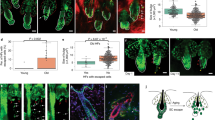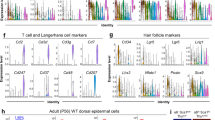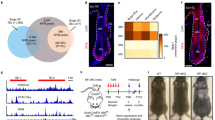Abstract
Trp53 loss of function has previously been shown to rescue tissue maintenance and developmental defects resulting from DNA damage or DNA-repair gene mutations1,2,3,4,5,6,7,8,9,10,11,12. Here, we report that p53 deficiency severely exacerbates tissue degeneration caused by mosaic deletion of the essential genome maintenance regulator Atr. Combined loss of Atr and p53 (Trp53−/−AtrmKO) led to severe defects in hair follicle regeneration, localized inflammation (Mac1+Gr1+ infiltrates), accelerated deterioration of the intestinal epithelium and synthetic lethality in adult mice. Tissue degeneration in Trp53−/−AtrmKO mice was characterized by the accumulation of cells maintaining high levels of DNA damage. Moreover, the elevated frequency of these damaged cells in both progenitor and downstream compartments in Trp53−/−AtrmKO skin coincided with delayed compensatory tissue renewal from residual ATR-expressing cells. Together, our results indicate that the combined loss of Atr and Trp53 in adult mice leads to the accumulation of highly damaged cells, which, consequently, impose a barrier to regeneration from undamaged progenitors.
This is a preview of subscription content, access via your institution
Access options
Subscribe to this journal
Receive 12 print issues and online access
$209.00 per year
only $17.42 per issue
Buy this article
- Purchase on Springer Link
- Instant access to full article PDF
Prices may be subject to local taxes which are calculated during checkout





Similar content being viewed by others
References
Wlodarski, P. et al. Role of p53 in hematopoietic recovery after cytotoxic treatment. Blood 91, 2998–3006 (1998).
Bender, C.F. et al. Cancer predisposition and hematopoietic failure in Rad50(S/S) mice. Genes Dev. 16, 2237–2251 (2002).
Chin, L. et al. p53 deficiency rescues the adverse effects of telomere loss and cooperates with telomere dysfunction to accelerate carcinogenesis. Cell 97, 527–538 (1999).
Frank, K.M. et al. DNA ligase IV deficiency in mice leads to defective neurogenesis and embryonic lethality via the p53 pathway. Mol. Cell 5, 993–1002 (2000).
Gao, Y. et al. Interplay of p53 and DNA-repair protein XRCC4 in tumorigenesis, genomic stability and development. Nature 404, 897–900 (2000).
Hakem, R., de la Pompa, J.L., Elia, A., Potter, J. & Mak, T.W. Partial rescue of Brca1 (5–6) early embryonic lethality by p53 or p21 null mutation. Nat. Genet. 16, 298–302 (1997).
Lim, D.S. & Hasty, P. A mutation in mouse rad51 results in an early embryonic lethal that is suppressed by a mutation in p53. Mol. Cell. Biol. 16, 7133–7143 (1996).
Lim, D.S. et al. Analysis of ku80-mutant mice and cells with deficient levels of p53. Mol. Cell. Biol. 20, 3772–3780 (2000).
Xu, Y., Yang, E.M., Brugarolas, J., Jacks, T. & Baltimore, D. Involvement of p53 and p21 in cellular defects and tumorigenesis in Atm−/− mice. Mol. Cell. Biol. 18, 4385–4390 (1998).
Xu, X. et al. Genetic interactions between tumor suppressors Brca1 and p53 in apoptosis, cell cycle and tumorigenesis. Nat. Genet. 28, 266–271 (2001).
Botchkarev, V.A. et al. p53 is essential for chemotherapy-induced hair loss. Cancer Res. 60, 5002–5006 (2000).
Orii, K.E., Lee, Y., Kondo, N. & McKinnon, P.J. Selective utilization of nonhomologous end-joining and homologous recombination DNA repair pathways during nervous system development. Proc. Natl. Acad. Sci. USA 103, 10017–10022 (2006).
Tyner, S.D. et al. p53 mutant mice that display early ageing-associated phenotypes. Nature 415, 45–53 (2002).
Maier, B. et al. Modulation of mammalian life span by the short isoform of p53. Genes Dev. 18, 306–319 (2004).
Matheu, A. et al. Delayed ageing through damage protection by the Arf/p53 pathway. Nature 448, 375–379 (2007).
Serrano, M. & Blasco, M.A. Cancer and ageing: convergent and divergent mechanisms. Nat. Rev. Mol. Cell Biol. 8, 715–722 (2007).
García-Cao, I. et al. Increased p53 activity does not accelerate telomere-driven ageing. EMBO Rep. 7, 546–552 (2006).
Krizhanovsky, V. et al. Senescence of activated stellate cells limits liver fibrosis. Cell 134, 657–667 (2008).
Brown, E.J. & Baltimore, D. ATR disruption leads to chromosomal fragmentation and early embryonic lethality. Genes Dev. 14, 397–402 (2000).
Brown, E.J. & Baltimore, D. Essential and dispensable roles of ATR in cell cycle arrest and genome maintenance. Genes Dev. 17, 615–628 (2003).
Chanoux, R.A. et al. ATR and H2AX Cooperate in Maintaining Genome Stability under Replication Stress. J. Biol. Chem. 284, 5994–6003 (2009).
Paulsen, R.D. & Cimprich, K.A. The ATR pathway: fine-tuning the fork. DNA Repair (Amst.) 6, 953–966 (2007).
Ruzankina, Y. et al. Deletion of the developmentally essential gene ATR in adult mice leads to age-related phenotypes and stem cell loss. Cell Stem Cell 1, 113–126 (2007).
Zhou, B.B. & Bartek, J. Targeting the checkpoint kinases: chemosensitization versus chemoprotection. Nat. Rev. Cancer 4, 216–225 (2004).
Nghiem, P., Park, P.K., Kim, Y., Vaziri, C. & Schreiber, S.L. ATR inhibition selectively sensitizes G1 checkpoint-deficient cells to lethal premature chromatin condensation. Proc. Natl. Acad. Sci. USA 98, 9092–9097 (2001).
Nghiem, P., Park, P.K., Kim Ys, Y.S., Desai, B.N. & Schreiber, S.L. ATR is not required for p53 activation but synergizes with p53 in the replication checkpoint. J. Biol. Chem. 277, 4428–4434 (2002).
Morris, R.J. et al. Capturing and profiling adult hair follicle stem cells. Nat. Biotechnol. 22, 411–417 (2004).
Greco, V. et al. A two-step mechanism for stem cell activation during hair regeneration. Cell Stem Cell 4, 155–169 (2009).
Blanpain, C., Lowry, W.E., Geoghegan, A., Polak, L. & Fuchs, E. Self-renewal, multipotency, and the existence of two cell populations within an epithelial stem cell niche. Cell 118, 635–648 (2004).
Coppé, J.P. et al. Senescence-associated secretory phenotypes reveal cell-nonautonomous functions of oncogenic RAS and the p53 tumor suppressor. PLoS Biol. 6, 2853–2868 (2008).
Kuilman, T. & Peeper, D.S. Senescence-messaging secretome: SMS-ing cellular stress. Nat. Rev. Cancer 9, 81–94 (2009).
Rodier, F. et al. Persistent DNA damage signalling triggers senescence-associated inflammatory cytokine secretion. Nat Cell Biol 11, 973–9 (2009).
Cortez, D., Guntuku, S., Qin, J. & Elledge, S.J. ATR and ATRIP: partners in checkpoint signaling. Science 294, 1713–1716 (2001).
Acknowledgements
We are indebted to G. Beatty, K. Cimprich, G. Cotsarelis and A. Bhandoola for reagents, protocols and helpful advice, and J. Wang and other members of the AFCRI Histology Core for tissue processing. These studies were supported by the US National Institute on Aging (R01AG027376 and F30AG034027) and the Abramson Family Cancer Research Institute.
Author information
Authors and Affiliations
Contributions
Y.R., D.W.S. and E.J.B. designed and interpreted the experiments and wrote the manuscript. Y.R. and D.W.S. performed all of the experiments, with assistance from A.A. (mouse maintenance, qPCR and histological analysis) and C.E.C. and R.H.V. (quantification of Gr1+Mac1+ cell infiltration).
Corresponding author
Supplementary information
Supplementary Text and Figures
Supplementary Figures 1–5 and Supplementary Table 1 (PDF 1979 kb)
Rights and permissions
About this article
Cite this article
Ruzankina, Y., Schoppy, D., Asare, A. et al. Tissue regenerative delays and synthetic lethality in adult mice after combined deletion of Atr and Trp53. Nat Genet 41, 1144–1149 (2009). https://doi.org/10.1038/ng.441
Received:
Accepted:
Published:
Issue Date:
DOI: https://doi.org/10.1038/ng.441
This article is cited by
-
Synthetic lethality in personalized cancer therapy
Genome Instability & Disease (2022)
-
ATM, ATR and DNA-PKcs kinases—the lessons from the mouse models: inhibition ≠ deletion
Cell & Bioscience (2020)
-
ATM, DNA-PKcs and ATR: shaping development through the regulation of the DNA damage responses
Genome Instability & Disease (2020)
-
Targeting ATR in cancer
Nature Reviews Cancer (2018)
-
Kinase-dead ATR differs from ATR loss by limiting the dynamic exchange of ATR and RPA
Nature Communications (2018)



